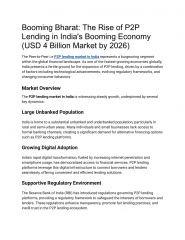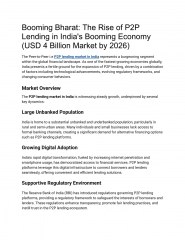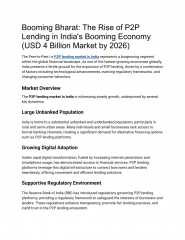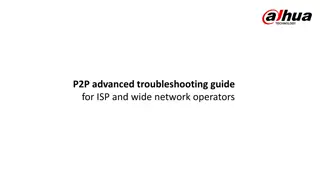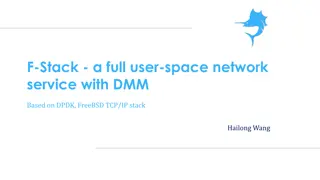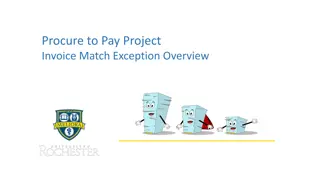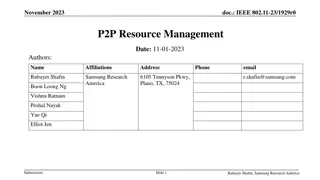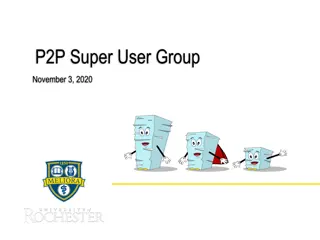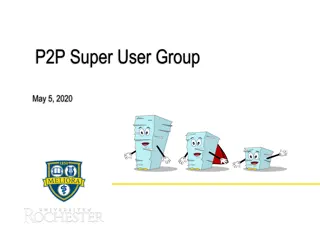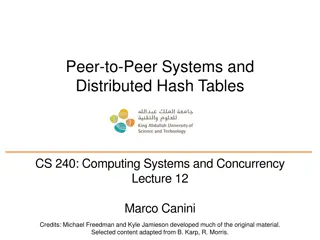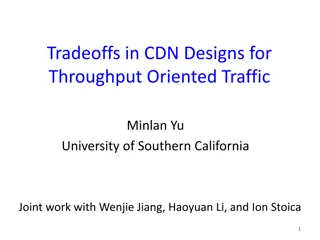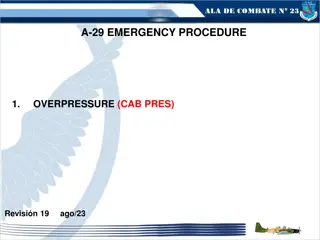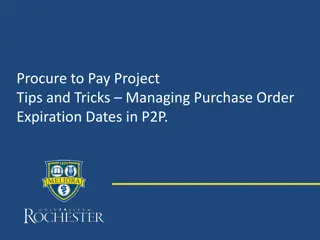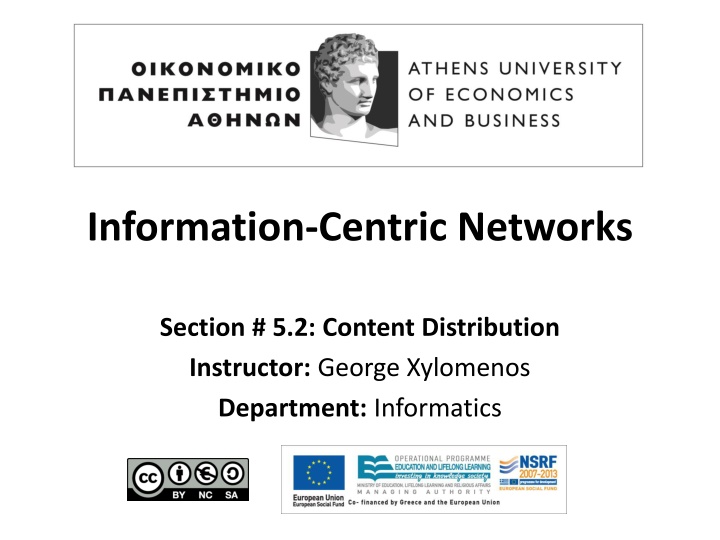
Peer-to-Peer Content Distribution Technologies Overview
Explore peer-to-peer (P2P) content distribution technologies including Gnutella, Kazaa, and Napster. Learn about the characteristics and classification of P2P architectures for efficient content sharing and collaboration in information-centric networks.
Download Presentation

Please find below an Image/Link to download the presentation.
The content on the website is provided AS IS for your information and personal use only. It may not be sold, licensed, or shared on other websites without obtaining consent from the author. If you encounter any issues during the download, it is possible that the publisher has removed the file from their server.
You are allowed to download the files provided on this website for personal or commercial use, subject to the condition that they are used lawfully. All files are the property of their respective owners.
The content on the website is provided AS IS for your information and personal use only. It may not be sold, licensed, or shared on other websites without obtaining consent from the author.
E N D
Presentation Transcript
Information-Centric Networks Section # 5.2: Content Distribution Instructor: George Xylomenos Department: Informatics
Funding These educational materials have been developed as part of the instructors educational tasks. The Athens University of Economics and Business Open Courses project only funded the reformatting of these educational materials. The project is being implemented as part of the Operational Program Instruction and Lifelong Learning and is co- financed by the European Union (European Social Fund) and national funds.
Licencing These educational materials are subject to a Creative Commons License.
Week 5 / Paper 2 A survey of peer-to-peer content distribution technologies Stephanos Androutsellis-Theotokis, Diomidis Spinellis CM Computing Surveys, Volume 36, Issue 4, 2004 Main point Content distribution is one of many uses of P2P Design decisions influence nonfunctional characteristics A taxonomy of P2P systems for content distribution is given Information-Centric Networks 05b-4
What is P2P? Gnutella? Kazaa? Or Napster? From purely distributed to based on centralized servers Some emphasize the use of resources at the edge But Napster also does that, although it relies on servers Two defining characteristics Sharing of resources by direct exchange Centralized servers only for specific tasks (e.g. bootstrap) Nodes need to participate in maintenance tasks Instability and variable connectivity is the norm Fault-tolerant and self-organizing capacity Definition of P2P based on above characteristics Covers Gnutella and Kazaa but not Napster However Napster is also mentioned as many see it as P2P Information-Centric Networks 05b-5
Classification of P2P architectures Communication and collaboration Chat and instant messaging Distributed computation Use of CPU cycles from the edge Internet service support Multicast, indirection, security Database systems Content distribution Focus of this study Support data exchange in various ways Direct file exchange between nodes (Gnutella) Shared storage media (Oceanstore) Information-Centric Networks 05b-6
Content distribution with P2P P2P applications Content distribution systems based on P2P technology P2P file exchange systems Facilities to search and transfer files between peers Generally best-effort P2P content publishing and storage Create a distributed storage medium Generally controlled access to the data P2P infrastructures Not working applications but substrates for them Routing and location Anonymity Reputation management Information-Centric Networks 05b-7
P2P object location and routing P2P nodes form an overlay network Connections between nodes are paths on a physical network Typically the physical (underlay) network is IP with UDP or TCP Overlay network centralization types Purely decentralized: all nodes are the same (servents) Partially centralized: some supernodes are more important Hybrid decentralized: central servers facilitate the network Network structure Unstructured: content placement unrelated to topology Content location is tricky (flooding or random walks) Structured: pointers to content are algorithmically placed Only works well with exact-match queries Loosely structured: routing hints to simplify content location Information-Centric Networks 05b-8
Unstructured architectures Hybrid decentralized (e.g. Napster, Publius) Central directory server Holds client info and file table Clients report their files to server The server updates its tables Clients send queries to server The server returns query results to clients Clients exchange files directly Inherently non-scalable, easy to take down It is sufficient to take down the centralized components Information-Centric Networks 05b-9
Unstructured architectures Purely decentralized (e.g. Gnutella) All nodes are equal (SERVer ENTIties, servents) Servents exchange 4 messages Ping: probe to a neighbor Pong: response to ping, contains number and size of files Query: search request (string) to neighbor Query Hit: response to query with matching file pointers First locate some hosts via public server, then send pings Then start sending queries Pings and queries are flooded up to a number of hops Duplicate detection mechanisms also limit flooding Responses are returned via the reverse path Download files directly from the servents having them Information-Centric Networks 05b-10
Unstructured architectures Partially centralized (e.g. Kazaa) Supernodes are dynamically assigned to assist others Supernodes are more powerful than other nodes (CPU, network) Index files shared by peers and proxy queries on their behalf All queries initially sent to supernodes Supernodes make queries much faster But they can be replaced if they fail Improving unstructured architectures The biggest problem is scalability Replace flooding by random walks Proactively replicate data Maintain local indices of data Information-Centric Networks 05b-11
Structured architectures Loosely structured systems (e.g. Freenet) Estimate which node is responsible for content Each node makes a local decision to forward queries In Freenet file names are hashed to produce keys There are 4 types of messages Data insert: includes data and key Data request: includes key and TTL Data reply: includes actual data Data failed: cannot find data On insert, each node estimates where similar keys are stored New files are placed close to files with similar keys Each node maintains a table with routing hints On query, local estimates towards possible targets are used Each successful response leaves behind a chain of pointers Information-Centric Networks 05b-12
Structured architectures Chord: uses a ring of nodes and keys Nodes are placed on a ring Each node knows its successor Keys are placed on the same ring Each key is stored at its successor Insertions/deletions of nodes only have local effect Some keys need to move to the next/previous node A finger table is used to speed up lookups Pointers to nodes at exponential distances Allows quick traversal of the ring Information-Centric Networks 05b-13
Structured architectures Tapestry (and Pastry, which is very similar) Nodes and keys are treated as n digit numbers Each node has a routing table with n rows In each row there are pointers to nodes with matching prefixes At row k nodes match the first k digits of the present node Routing proceeds by matching one digit at a time There is some leeway in choosing routing entries Any node with a matching prefix will do Normally choose the closest one Extensions allow replication of data Information-Centric Networks 05b-14
Structured architectures CAN (Content Addressable Network) Multi-dimensional key space Keys and nodes are mapped to points in the space Nodes split the space between them based on proximity Keys are stored at the node within which their point resides Insertions/deletions of nodes require splitting/merging areas Routing proceeds between neighbor nodes Improving structured architectures The biggest problem is inexact matches Various proposals for building indexes on top Insert pointers to files with the right keywords as names Maintenance is also quite heavy At least compared to unstructured architectures Information-Centric Networks 05b-15
Caching, replication and migration Replication improves availability and performance Passive replication Occurs as nodes exchange content Cache-based replication Cache responses passing through the node Active replication Push data proactively Introspective replica management Observe traffic to decide on replication Dynamic replica management If queries are slow, place additional replicas Information-Centric Networks 05b-16
Security Secure storage of data Self-certification File names contain a hash of the content Information dispersal Encode the data as m blocks and spread them in the network Require any n<m blocks to retrieve the data Can be extended to secretly share keys Anonymous cryptographic relays Data is sent to forwarders with send it to storers The publisher destroys the data and publishes the storers Information-Centric Networks 05b-17
Security Access control, authentication and identity management P2P systems are decentralized The same entity can appear with many names This can subvert content replication, routing, etc. Reputation management also cannot work The use of multiple fake identities is called a Sybil attack Some systems use access control mechanisms Only users with specific keys can access content Other systems use challenges to prevent Sybil attacks Need to spend some CPU cycles to be accepted Small numbers of nodes cannot mount large attacks Information-Centric Networks 05b-18
Anonymity and deniability Anonymity May refer to publisher, storer, content or query Dissassociation of content source and requestor Prevent linking files with origin or destination Anonymous connection layers Onion routing and mix routing obscure the routing process Censorship resistant lookup Deniability Deniability of stored content Normally based on encryption or steganography Deniability of content in transit Via anonymous connection layers Information-Centric Networks 05b-19
Incentives and accountability Trust-based versus trade-based incentive mechanisms Prevent free-rider behavior in decentralized systems Reputation mechanisms Need to propagate local reputation estimates globally Quite tricky in a decentralized environment Many simple mechanisms are easily subverted Micropayment mechanisms Implement a micro currency scheme Resource trading schemes Nodes issue receipts for services offered Receipts indicate the quality of an entity Information-Centric Networks 05b-20
Content management capabilities Content deletion and update Some systems only support immutable files Others search for and remove old copies of files Content expiration Easy way to get rid of stale data Content versioning Used in Oceanstore for archival storage Directory structures Mnemosyne provides UNIX like directories Content searching (see structured vs. unstructured) Storage and bandwidth management Information-Centric Networks 05b-21
End of Section # 5.2 Course: Information-Centric Networks, Section # 5.2: Content Distribution Instructor: George Xylomenos, Department: Informatics

